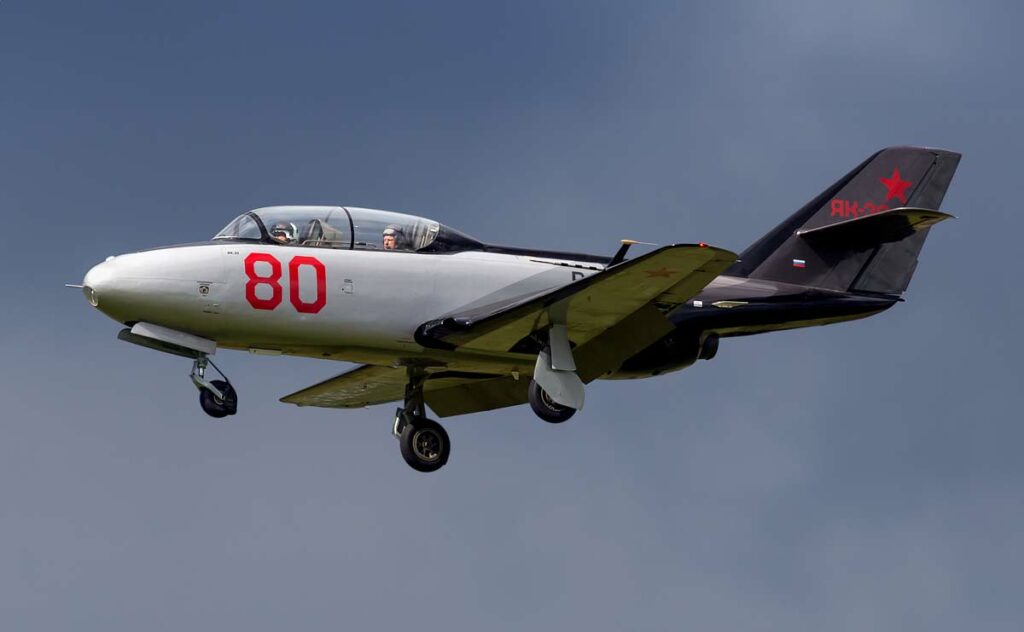The Yakovlev Yak-30 (Magnum) was an advanced Soviet jet trainer prototype with a focus on high performance and agility.
In brief
The Yakovlev Yak-30, also known by its NATO reporting name “Magnum,” was a Soviet jet trainer aircraft designed in the early 1960s. As a prototype, it showcased advanced aerodynamics, including a swept wing design, a tricycle landing gear system for improved ground handling, and a pressurized cockpit accommodating two crew members in a tandem configuration. Powered by a single turbojet engine, the Yak-30 was intended to provide high-speed training capabilities, simulating the performance characteristics of contemporary fighter jets. Although it demonstrated promising flight characteristics during testing, the Yak-30 did not proceed beyond the prototype stage.
The Yakovlev Yak-30 (Magnum) represents a curious footnote in aviation history. As a prototype developed by the renowned Yakovlev design bureau, it was part of the Soviet Union’s efforts to modernize its training aircraft fleet, aiming to bridge the gap between basic trainers and frontline fighters.
History of the Development
In the context of the early 1960s, the Soviet Air Force sought to enhance its training regimen by introducing a jet capable of preparing pilots for the demands of flying second and third-generation fighters. The Yakovlev design bureau, with a long history of producing successful aircraft, undertook the development of the Yak-30 with these goals in mind.
The program was launched to create a trainer that could offer advanced flight characteristics, including the ability to simulate the high-speed and high-altitude performance of contemporary fighters. This initiative was part of a broader trend in military aviation, where the increasing complexity and capabilities of frontline aircraft necessitated more sophisticated training platforms.
The Yak-30 made its first flight in 1960, showcasing Yakovlev’s commitment to pushing the boundaries of Soviet aviation technology. Despite its promising features, the Yak-30 faced competition from other designs and did not enter mass production. The specific reasons behind this decision remain a blend of technical, strategic, and political factors, typical of the era’s military procurement processes.
Design of the Yakovlev Yak-30 (Magnum)
The Yak-30 was designed with a focus on performance, agility, and pilot training effectiveness. It featured a sleek, aerodynamic profile with swept wings that contributed to its high-speed capabilities. The aircraft’s dimensions and weight were optimized for its role as a trainer, balancing maneuverability with stability.
Technical specifications, such as the exact dimensions, engine type, and performance metrics, are based on the limited availability of detailed historical data. However, the design philosophy emphasized creating a realistic training environment for pilots transitioning to high-performance jets, incorporating features like ejection seats for safety and an advanced avionics suite for the time.
The main advantages of the Yak-30’s design included its potential to closely mimic the flight characteristics of operational fighters, offering valuable training experiences without the costs associated with using actual combat aircraft for instruction. Drawbacks might have included the challenges of maintaining a specialized fleet solely for advanced training, especially in the context of budget constraints and the competing priorities of military procurement.

Performance of the Yakovlev Yak-30 (Magnum)
Analyzing the performance of the Yak-30 in comparison to contemporaneous aircraft involves considering its intended role as a trainer rather than a front-line combat aircraft. Its single turbojet engine was selected to provide a balance of power, efficiency, and reliability, enabling the aircraft to achieve speeds and altitudes sufficient for advanced training missions.
The Yak-30’s performance parameters, such as maximum speed, service ceiling, and range, would have been competitive with other training aircraft of the era, offering a platform capable of preparing pilots for the rigors of supersonic jet operations. The aircraft’s agility and handling characteristics were also critical, providing realistic training for air combat maneuvering and other tactical skills.
Variants of the Yakovlev Yak-30 (Magnum)
As a prototype that did not enter mass production, the Yak-30 did not develop into a family of variants with differing specifications and roles. The primary focus remained on evaluating its potential as an advanced jet trainer, with any planned variants or modifications remaining speculative and unimplemented.
Military Use and Combat of the Yakovlev Yak-30 (Magnum)
Given its status as a prototype that did not advance to operational service, the Yak-30 (Magnum) did not see military use or combat. Its development and testing phase represented a period of evaluation and experimentation rather than a transition to widespread adoption by the Soviet Air Force or sales to other countries.
The Yakovlev Yak-30 (Magnum) stands as a testament to the innovation and ambition of Soviet aircraft design during a period of rapid technological advancement. Despite its limited role in aviation history, the Yak-30’s development offers valuable insights into the challenges and priorities of military training aircraft design in the Cold War era.